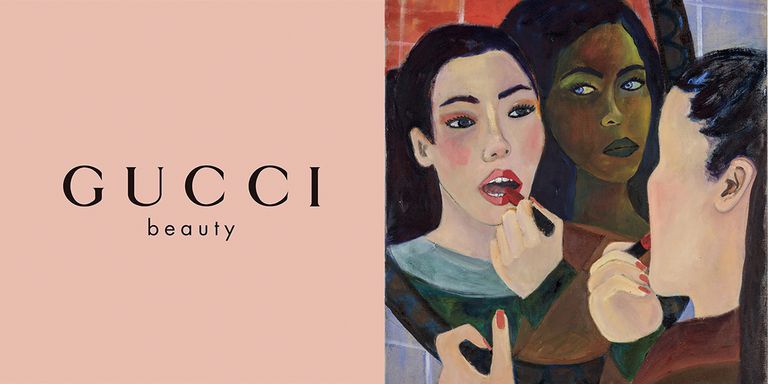У Gucci появилась необычная бьюти-страница в Instagram – @guccibeauty (Gucci Beauty), которая больше напоминает аккаунт художественного музея.
Об этом пишет Quartz .
Так, вместо фото бьюти-продуктов или макияжей, на ней публикуются изображения произведений живописи.
Данный аккаунт будет транслировать видение красоты нынешнего креативного директора бренда Алессандро Микеле, пишет ELLE .
На Instagram-странице размещаются художественные работы – портреты людей различной этнической принадлежности, из разных эпох, которые входят в коллекции Галереи Уффици во Флоренции, Музея Метрополитен в Нью-Йорке и Музея-студии Гарлема.
Фото: ELLE
Таким образом, вместо рекламы новой помады или теней пользователям соцсети предлагается ознакомиться с историей искусства в доступном и понятном формате. Каждая опубликованная художественная работа сопровождается кратким описанием и историей создания.
Идея заключается в том, что на полотнах запечатлены идеалы красоты, характерные для определенного места и эпохи, и пользователям предлагается приобщиться к миру прекрасного.
В данный момент на страницу подписаны уже более 40 тыс. пользователей.
Ожидается, что в будущем бренд будет анонсировать в данном аккаунте запуски новинок, демонстрировать рекламные кампании и специальные коллаборации.
Посмотреть эту публикацию в Instagram
Title: Jewish Woman from Tangiers, 1874 Author: Charles Landelle Museum: Musée des Beaux-Arts, Reims ⠀⠀⠀⠀⠀⠀⠀⠀⠀⠀⠀ Jewish women are largely absent from the tradition of European painting. When they were depicted, it was often with an exoticizing touch and a strong emphasis on their otherness. That’s somewhat the case here in this 19th-century portrait by the popular French artist Charles Landelle, in the collection of the Musée des Beaux-Arts, Reims. An Orientalist painter, he was seduced by the culture he witnessed during his travels to North Africa and the Middle East and it became the focus of much of his oeuvre. Though his version of Moroccan culture wasn’t exactly accurate, he brought a delicate touch to his depiction of this dark-eyed young woman, rendering her features with care. Under Landelle’s brush, she appears mysterious, beautiful, and ultimately unknowable. #GucciBeauty — @tatianaberg Musée des Beaux-Arts, Reims, France / J.P. Zenobel / Bridgeman Images
Публикация от Gucci Beauty (@guccibeauty) 22 Сен 2018 в 10:38 PDT
Посмотреть эту публикацию в Instagram
Gucci launches #GucciBeauty with a series of artworks traversing gender, history and culture, guided by #AlessandroMichele’s vision of the world of beauty. ⠀⠀⠀⠀⠀⠀⠀⠀⠀⠀⠀ Title: Princess Elizabeth, Queen of Bohemia and Electress Palatine, 1613 Author: Unknown artist Museum: National Portrait Gallery, London ⠀⠀⠀⠀⠀⠀⠀⠀⠀⠀⠀ The subject of this portrait at the London National Portrait Gallery, Queen Elizabeth of Bohemia, was married to Frederick V in 1613 with a wedding that nearly bankrupted the King — including the likely wedding dress in the painting, with its elaborate brocade of lace showing heraldic lions and unicorns. Frederick was elected King of Bohemia in 1619 but was defeated in battle in 1620. After her exile and Frederick’s death, Elizabeth became a patroness of the arts and commissioned portraits like this. The current British monarch, Elizabeth II, is her direct descendant 10 generations later. #GucciBeauty #NationalPortraitGallery — National Portrait Gallery, London
Публикация от Gucci Beauty (@guccibeauty) 20 Сен 2018 в 3:25 PDT
Посмотреть эту публикацию в Instagram
Title: Elegant: A Lady of the Imperial Court in the Kyōwa Period (1801 – 1803) Author: Tsukioka Yoshitoshi Museum: LACMA, Los Angeles ⠀⠀⠀⠀⠀⠀⠀⠀⠀⠀⠀ The Japanese artist Tsukioka Yoshitoshi is known as the last great innovator of the ukiyo-e woodblock print genre before he died in 1898, having suffered depressive episodes his entire life. Trained to draw from life, Yoshitoshi’s subjects ranged from depictions of graphic violence to series of beautiful women. In hard times during his early career, the artist was often supported by his mistress, Okoto. This image, from @LACMA, one of the #GucciPlaces, shows an ideal beauty from the Kyowa period, at the turn of the 19th century. The woman is swaddled in thick robes, her skin painted white. #GucciBeauty — @kchayka Image courtesy of LACMA
Публикация от Gucci Beauty (@guccibeauty) 19 Сен 2018 в 9:21 PDT
Посмотреть эту публикацию в Instagram
Title: Girl with Cherries, c. 1491 Author: Giovanni Ambrogio de Predis Museum: Metropolitan Museum of Arts, New York ⠀⠀⠀⠀⠀⠀⠀⠀⠀⠀⠀ Pomona, the Roman goddess of fruit, serves as the symbolic subject of this 1491 painting in the collection of the @metmuseum. Initially believed to be the work of Leonardo da Vinci, the portrait is now most often attributed to Giovanni Ambrogio de Predis, a close follower of Leonardo’s work. The similarities abound, such as the subtle turn of her head and her distracted eyes. Leonardo loved the naturalistic movement of hair, clearly referenced here through the subject’s curls, depicted with full body and a shimmering golden light caressing each wave. #GucciBeauty #TheMet — @britticisms Marquand Collection, Gift of Henry G. Marquand, 1890
Публикация от Gucci Beauty (@guccibeauty) 21 Сен 2018 в 4:18 PDT






